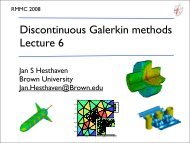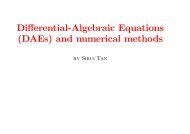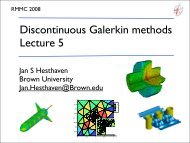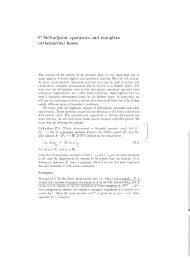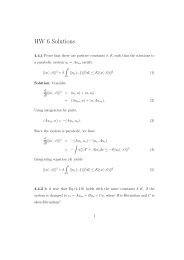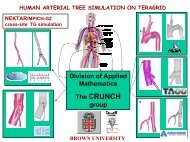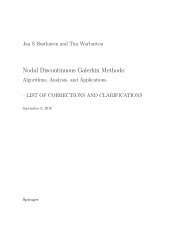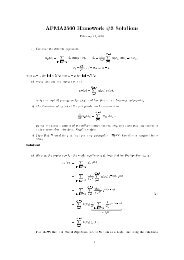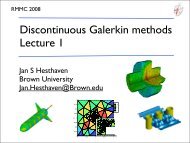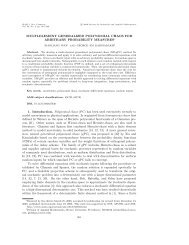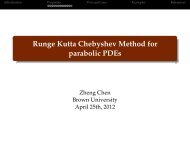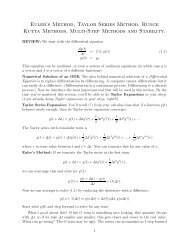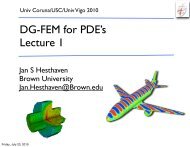Discontinuous Galerkin methods Lecture 3 - Brown University
Discontinuous Galerkin methods Lecture 3 - Brown University
Discontinuous Galerkin methods Lecture 3 - Brown University
Create successful ePaper yourself
Turn your PDF publications into a flip-book with our unique Google optimized e-Paper software.
simplicity, we assume that all elements have length h (i.e., D k = x k + r<br />
˜Pn(r) = Pn(r)<br />
√ , γn =<br />
γn<br />
2<br />
2n +1 .<br />
simplicity, we assume that all elements have length h (i.e., D<br />
Approximation theory<br />
k = xk +<br />
where xk = 1<br />
2 (xkr +xk where x<br />
l ) represents the cell center and r ∈ [−1, 1] is the refere<br />
k = 1<br />
2 (xk r +xk l ) represents the cell center and r ∈ vh(r) [−1, 1] = is the reference ˆvn<br />
coordinate).<br />
n=0<br />
˜ Pn(r),<br />
assic Legendre polynomials of order n. A key property<br />
s that they satisfy a singular Sturm-Liouville problem<br />
coordinate). We begin by considering the standard interval and introduce the new vari-<br />
We able Let begin us assume by considering all elements the standard have interval size h and introduce consider the new va<br />
able<br />
v(r) =u(hr) =u(x);<br />
that is, v is defined on thev(r) standard =u(hr) interval, =u(x); I =[−1, 1], and xk represents v ∈ L<br />
4.3 Approximations by orthogonal polynomials and consistency 79<br />
= 0, x ∈<br />
2 (I). Note, that for simplicity of the n<br />
with standard notation, we now have the sum runn<br />
than from 1 to N + 1 = Np, as used previously.<br />
d<br />
r<br />
[−h, h]. We discussed in Chapter 3 the advantage of using a local orthonormal<br />
(1 − r2 ) d<br />
dr ˜ Pn + n(n + 1) ˜ Pn =0. (4.2)<br />
An immediate consequence of<br />
Prior<br />
the orthonormality<br />
to discussing<br />
of<br />
interpolation,<br />
the basis is that<br />
used throughou<br />
sic question of how well the properties∞ of the projection where we utilize the<br />
We consider expansions as<br />
that is, v is defined on the standard interval, I =[−1, 1], and xk basis – in this case, the normalized Legendre polynomials<br />
= 0, x<br />
[−h, h]. We discussed in Chapter 3 the advantage of using a local orthonorm<br />
basis – in this case, the normalized ˜Pn(r) = Legendre polynomials<br />
Pn(r)<br />
v − vh<br />
N<br />
2<br />
2<br />
I = |˜vn|<br />
n=N+1<br />
2 to find ,<br />
˜vn as<br />
<br />
˜Pn(r) = Pn(r) 2<br />
√ , γn =<br />
γn 2n +1 .<br />
√ , γn =<br />
γn 2n +1 .<br />
Here, Pn(r) are the classic Legendre polynomials of order n. A key property<br />
of these polynomials is that they satisfy a singular Sturm-Liouville problem<br />
d<br />
dr (1 − r2 ) d<br />
Let us consider the basic question of how well<br />
vh(r) = ˆvn ˜ vh(r) = ˆvn<br />
n=0<br />
Pn(r),<br />
˜ Pn(r),<br />
ote, that for simplicity of the notation and to conform<br />
n, we now have the sum running from 0 to N rather<br />
= Np, as used previously.<br />
projection where we utilize the orthonomality of ˜ Pn(r)<br />
<br />
˜vn = v(r)<br />
I<br />
˜ recognized as Parseval’s identity. A basic result for this approximation error<br />
follows directly.<br />
Theorem 4.1. Assume that v ∈ H<br />
Pn(r) dr.<br />
p ˜vn = v(r)<br />
I<br />
(I) and that vh represents a polynomial<br />
projection of order N. Then<br />
where<br />
<br />
3q,<br />
0 ≤ q ≤ 1<br />
and 0 ≤ q ≤ p.<br />
˜ Pn(r) dr.<br />
Here, Pn(r) are the classic Legendre polynomials of order n. A key prope<br />
dr<br />
of these polynomials is that they satisfy a singular Sturm-Liouville proble<br />
˜ Pn + n(n + 1) ˜ Pn interpolation, used throughout v −this vhtext, I,q ≤ we N consider =0. (4.2)<br />
ρ−p |v| I,p ,<br />
d<br />
dr (1 − r2 ) d<br />
dr ˜ Pn + n(n + 1) ˜ ρ = 2<br />
2q − N Pn =0. (4<br />
1<br />
2 , q ≥ 1<br />
n=0<br />
Let us consider the basic question of how well<br />
Proof. We will just sketch the proof; the details can be found in [43]. Com-<br />
bining the definition 2 of ˜vn and Eq. (4.2), we recover<br />
N<br />
2 h



